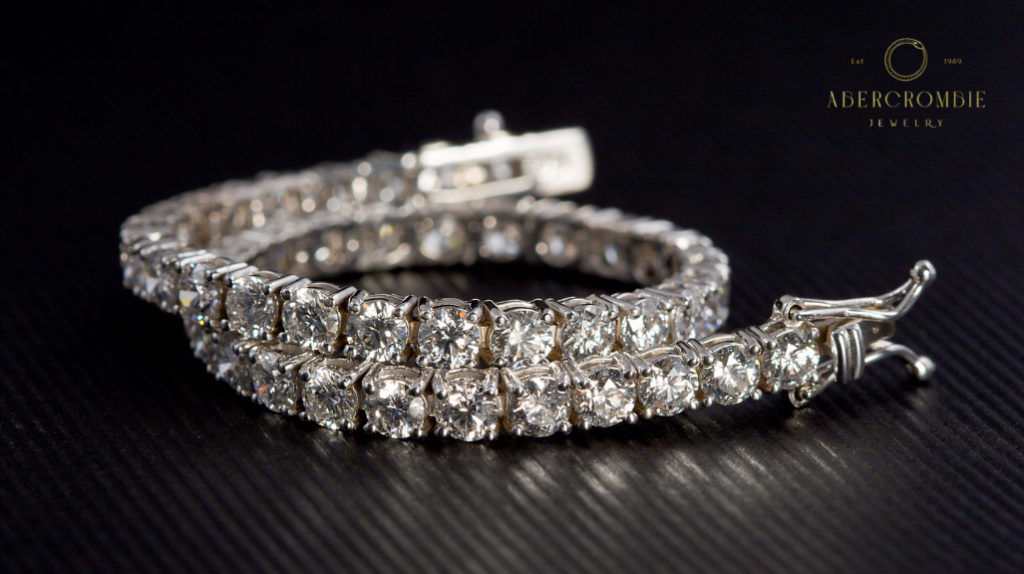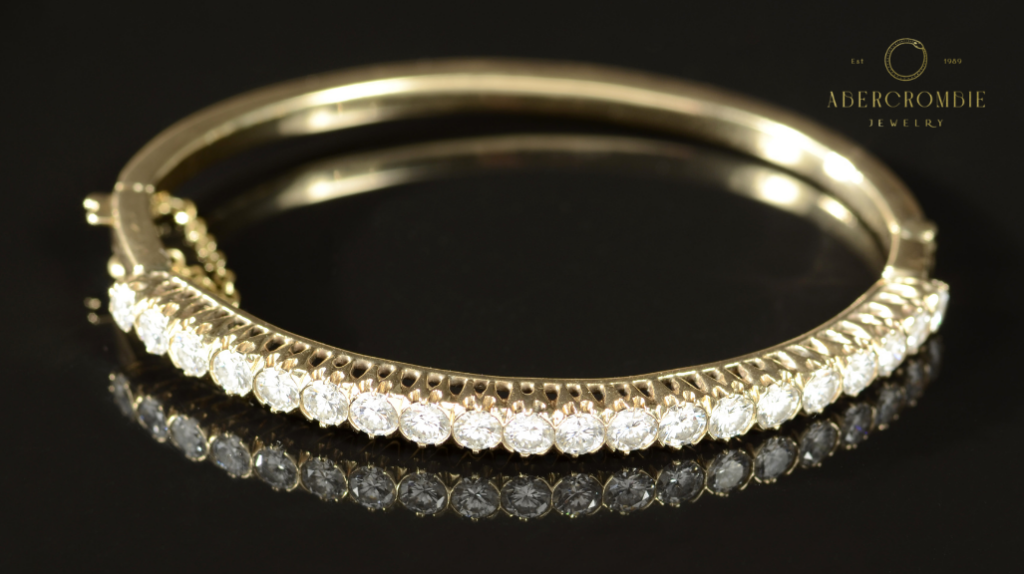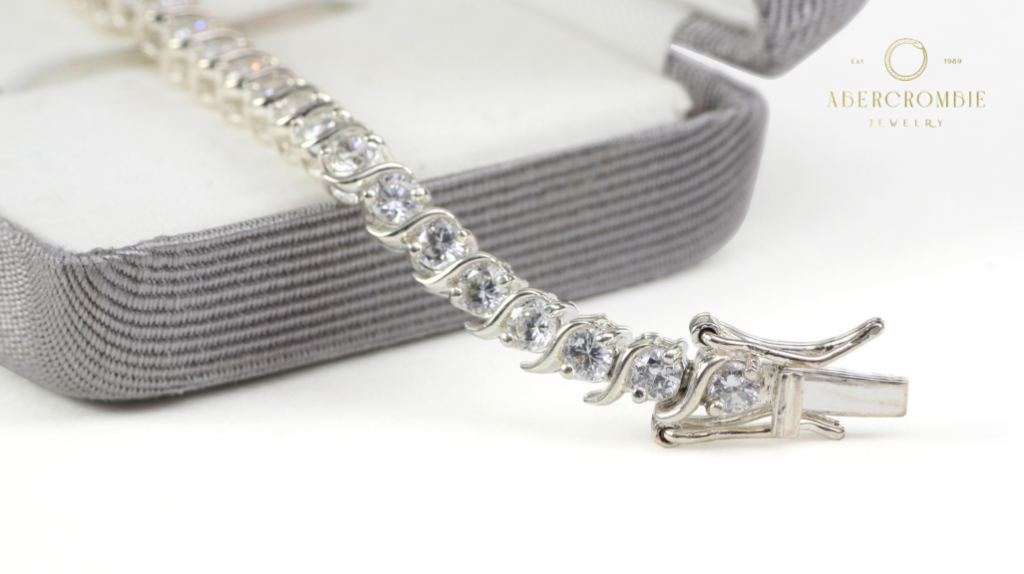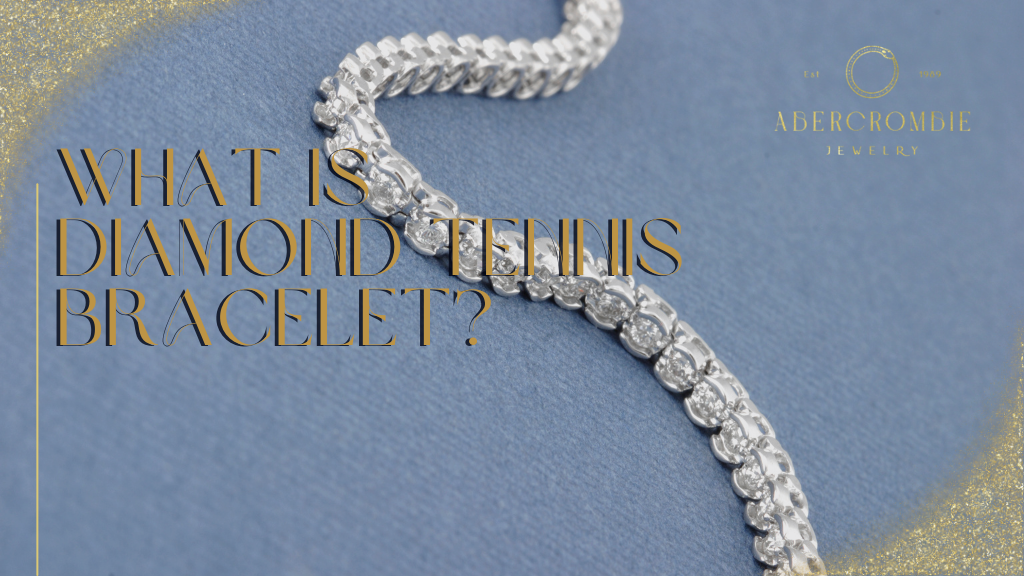Diamond tennis bracelets often serve as an understated companion to the more flamboyant pieces in one’s collection. Yet, they carve out a unique niche with their seamless elegance and casual charm. This distinctive allure sets them apart in fine jewelry, marking the diamond tennis bracelet as a category with merit.
Key components of a diamond tennis bracelet include its quality diamonds and the choice of metal—ranging from various karats of gold to platinum—each known for enhancing the bracelet’s beauty and durability. Single-row and multi-row designs also stand out, offering a range of styles from understated to statement-making. Delving a bit deeper, each aspect of a diamond tennis bracelet—from the quality and cut of the diamonds to the craftsmanship of the setting—presents its considerations, aesthetic appeal, historical significance, and even recommendations for occasions best suited to wear them.
The following sections will explore these facets in detail, providing a deeper appreciation of what makes the diamond tennis bracelet a coveted accessory worldwide.
Definition of a Diamond Tennis Bracelet
A diamond tennis bracelet is a piece of jewelry that epitomizes elegance and simplicity, making it a versatile accessory for numerous occasions. It is distinguished by its design, which features a delicate chain of precious metal—gold in various shades or the sleek allure of platinum—adorned with a continuous line of diamonds. These diamonds are carefully selected and matched for size and quality, ensuring a uniform and captivating appearance.
The essence of a diamond tennis bracelet lies in its ability to showcase the brilliance and fire of the diamonds, often enhanced by the cut chosen to maximize their sparkle. The name “tennis bracelet” has its roots in a memorable sporting event that not only popularized this jewelry style but also gave it its name. This blend of luxury and practicality has cemented the diamond tennis bracelet as a symbol of timeless elegance, characterized by its strength and beauty.
The metal settings, whether the traditional elegance of gold or the modern durability of platinum, play a crucial role in highlighting the natural beauty of the diamonds, making the diamond tennis bracelet a testament to the harmonious balance between durability and aesthetic appeal.
History of the Diamond Tennis Bracelet

The diamond tennis bracelet boasts a fascinating and unique history rooted in a memorable event from the 1987 U.S. Open. It was during this prestigious tennis tournament that the term “tennis bracelet” was born.
The spotlight shone on the bracelet when Chris Evert, a professional tennis player, halted her match to retrieve her diamond bracelet that had unclasped and fallen onto the court. This moment highlighted the bracelet’s delicate beauty and forever linked its identity with the sport of tennis, marking a turning point in jewelry fashion. Following this incident, the popularity of the diamond tennis bracelet skyrocketed, capturing the hearts of sports enthusiasts, celebrities, and royalty.
Its allure was not just in its connection to a moment of grace under pressure but also in its embodiment of athleticism blended with timeless elegance. This rich history has transformed the diamond tennis bracelet from a mere accessory into a symbol of enduring style and sophistication, making it a cherished item in jewelry collections across the globe.
Origin in the 1987 U.S. Open
The origin of the diamond tennis bracelet is deeply linked to a memorable incident during the 1987 U.S. Open. This event unfolded when Chris Evert, a celebrated professional tennis player, paused her match to look for her diamond bracelet after it had unexpectedly unclasped and dropped onto the court.
The incident caused a temporary halt in the game, drawing attention from viewers worldwide. The aftermath of this event saw a surge in demand for similar bracelets, prompting jewelry designers and manufacturers to increase production to meet the newfound interest. This moment served as a catalyst, merging the worlds of sports and high fashion, and led to the coining of the term “tennis bracelet.” Jewelers capitalized on this trend, enhancing their designs to ensure the bracelets were beautiful and secure enough for active wear.
Popularity among celebrities and royalty
After its iconic moment at the U.S. Open, the popularity of the diamond tennis bracelet rapidly expanded beyond the sports world, capturing the hearts of celebrities and royalty. Notable figures such as Princess Diana and Hollywood stars like Elizabeth Taylor were often seen adorning these elegant pieces, further cementing their status as a symbol of luxury and sophistication.
In recent years, celebrities like Serena Williams and Meghan Markle have been spotted wearing diamond tennis bracelets, showcasing their enduring appeal and versatility across different eras and styles. The diamond tennis bracelet’s understated yet sophisticated design has made it a perennial favorite among fashion icons and style leaders across generations, solidifying its position as a quintessential accessory in high fashion and distinguished social circles. Its ability to transcend trends and remain relevant in the ever-evolving world of fashion highlights its timeless elegance and enduring charm.
Components of a Diamond Tennis Bracelet

The components of a diamond tennis bracelet are pivotal in defining its allure, combining beauty with durability. Central to its design are the diamonds, chosen with meticulous care for their quality and ability to dazzle. These gems undergo a rigorous selection process, graded by certified gemologists to ensure they meet the stringent standards of clarity, color, and cut—the latter being crucial for that sought-after sparkle.
Encasing these diamonds is the choice of metal, which varies from the traditional elegance of gold in its many hues to the sleek durability of platinum. Gold options include yellow, white, and rose, each offering a different aesthetic to complement the brilliance of the diamonds. Platinum stands out for its strength and luster, providing a contemporary flair while ensuring the bracelet’s longevity.
Together, these components meld to form a piece that is not just an accessory but a masterpiece of craftsmanship and quality, embodying both the timeless elegance and the enduring strength of a diamond tennis bracelet.
Diamonds
The heart of the diamond tennis bracelet is the diamonds chosen for their unmatched quality and brilliance. These precious stones are the essence of the bracelet’s allure, sparkling with every movement.
Popular Diamond Shapes for Tennis Bracelets
| Diamond Shape | Description |
| Round | Offers maximum brilliance and sparkle. |
| Princess Cut | Provides a modern and elegant appearance. |
Quality Graded by Certified Gemologists
Each diamond is quality-graded by certified gemologists, ensuring that every gem meets stringent standards for clarity and color. This meticulous selection process guarantees the bracelet’s beauty and value.
| Grading System | Description |
| GIA | The Gemological Institute of America is known for strict grading standards. |
| AGS | American Gem Society uses a unique cut grading system. |
Cut for Maximum Brilliance
The cut of the diamonds is masterfully executed to achieve maximum brilliance. This critical aspect enhances the gems’ ability to capture and reflect light, creating a truly captivating, mesmerizing sparkle.
Metal Types
The choice of metal plays a significant role in the bracelet’s appearance and durability.
Gold in Various Karats and Colors
Gold, offered in various karats and colors like yellow, white, and rose, provides a rich and versatile diamond backdrop. Each color option offers a unique aesthetic for personal expression and style.
Platinum for Durability and Luster
Platinum is celebrated for its durability and luster, offering a sleek and modern alternative. Its robust nature ensures the bracelet’s longevity, while its natural white sheen perfectly complements the brilliance of the diamonds.
| Metal Type | Characteristics |
| Gold | Available in yellow, white, and rose; it offers a traditional or modern look. |
| Platinum | Known for its strength, durability, and natural white luster that enhances diamonds. |
Choosing a Diamond Tennis Bracelet

Selecting the perfect diamond tennis bracelet requires attention to the 4Cs of diamonds: Carat, Clarity, Color, and Cut. These elements greatly influence the bracelet’s price and appearance. The carat weight plays a pivotal role in determining the bracelet’s visual impact, with larger diamonds offering more brilliance but also a higher price tag.
Clarity is essential, as it assesses the diamond’s purity and the presence of inclusions, with higher clarity indicating a more flawless gem. The color of a diamond ranges from colorless to yellow, with colorless diamonds being most sought after for their unmatched brilliance. The cut is critical for maximizing the diamond’s sparkle and fire, reflecting the skill of the craftsmanship involved.
When it comes to metal type, the choice between gold and platinum can significantly alter the bracelet’s look and longevity. Gold provides a classic elegance and is available in various karats and colors, including yellow, white, and rose, allowing for personal customization. Platinum, on the other hand, offers unmatched durability and luster, appealing to those desiring a more contemporary aesthetic.
Determining the bracelet’s length is crucial for ensuring a comfortable and secure fit. Standard lengths vary according to wrist size, but custom lengths can be crafted for a personalized fit. This consideration ensures that the bracelet is not only aesthetically pleasing but also practical for everyday wear, blending beauty with functionality.
Considering the 4Cs of Diamonds
When selecting a diamond tennis bracelet, the 4Cs of Diamonds—Carat, Clarity, Color, and Cut—are crucial factors that influence both the bracelet’s beauty and its value.
| C | Impact on Aesthetics & Price |
| Carat | Larger carat weights increase brilliance and price. Smaller diamonds can offer a delicate elegance at a more accessible price point. |
| Clarity | Higher clarity diamonds have fewer inclusions, enhancing the bracelet’s sparkle. Lower clarity can be more affordable but may lack the same brilliance. |
| Color | Colorless diamonds (graded D-F) offer the most sparkle and are priced higher. Near-colorless (G-J) can provide excellent value with slight differences in sparkle. |
| Cut | The cut determines the diamond’s ability to reflect light. Ideal or Excellent cuts provide maximum brilliance and fire, affecting the bracelet’s overall sparkle and, consequently, its price. |
Selecting the Metal Type
The choice of metal affects the bracelet’s appearance, durability, and maintenance requirements.
| Metal Type | Properties | Maintenance Needs | Hypoallergenic Properties |
| Gold | Offers a classic look. Available in yellow, white, and rose. | Requires regular cleaning to maintain shine. Prone to scratches. | Generally good, especially high-karat gold. However, white gold may contain nickel, which can cause allergic reactions. |
| Platinum | Durable and maintains luster without tarnishing. Heavier than gold. | Low maintenance. More resistant to scratches compared to gold. | Yes, it is highly hypoallergenic and ideal for sensitive skin. |
Determining the Bracelet Length
Ensuring a perfect fit is essential for comfort and security. Here’s a guide on how to measure your wrist for a diamond tennis bracelet:
- Measure Your Wrist: Use a flexible measuring tape or a piece of string to wrap around your wrist snugly. Mark where the ends meet and measure the length against a ruler.
- Add Length: For a comfortable fit, add ½ inch to 1 inch (1.27 cm to 2.54 cm) to your wrist measurement. This is your ideal bracelet length.
- Consult Sizing Charts: Many jewelers offer sizing charts. Compare your measurements to find the perfect fit.
| Wrist Measurement (inches) | Recommended Bracelet Length (inches) |
| 5.5 | 6.0 – 6.5 |
| 6.0 | 6.5 – 7.0 |
| 6.5 | 7.0 – 7.5 |
| 7.0 | 7.5 – 8.0 |
Adjustments and custom lengths are available for those who fall outside these standard sizes or prefer a different fit.
Caring for a Diamond Tennis Bracelet

Adopting a routine of regular care is essential to ensure the lasting beauty and integrity of a diamond tennis bracelet. Cleaning the bracelet with mild soap and water is a simple yet effective way to maintain its luster by removing everyday dirt and grime that can accumulate on the diamonds and the metal setting. Beyond home care, scheduling professional inspections is crucial for checking the security of the bracelet’s settings and the condition of the diamonds.
These proactive steps help preserve the bracelet’s stunning appearance and extend its lifespan, ensuring that it remains a treasured accessory for years to come.
Regular Cleaning with mild soap and water
Regular Cleaning is essential to maintain the sparkle and luster of a diamond tennis bracelet. Here is a step-by-step guide for effective Cleaning.:
- Prepare a Cleaning Solution: Mix a small amount of mild dish soap with warm water.
- Soak the Bracelet: Place the bracelet in the solution and let it soak for 15-20 minutes. This helps loosen any dirt.
- Gently Brush: Use a soft-bristled brush (a soft toothbrush works well) to gently scrub the diamonds and metal setting. Be careful around the prongs to avoid loosening them.
- Rinse Thoroughly: Rinse the bracelet under warm running water to remove any soap residue. Ensure the sink drain is closed, or use a strainer to prevent loss.
- Dry: Pat the bracelet dry with a soft, lint-free cloth. Allow it to air dry completely before storing or wearing.
Professional Inspections for secure settings
Scheduling professional inspections is crucial for the long-term care of a diamond tennis bracelet. Here’s what happens during a professional inspection and how often it should be done:
| Activity | Description |
| Visual Inspection | A jeweler will examine the bracelet for any visible signs of damage or wear, particularly focusing on the prongs and clasps to ensure they are secure. |
| Cleaning | The jeweler may also professionally clean the bracelet, removing any buildup that home cleaning can’t address. |
| Repair Recommendations | If any issues are found, such as loose diamonds or weakened clasps, the jeweler will recommend necessary repairs to prevent loss or further damage. |
Frequency of Professional Inspections:
- Every 6 to 12 months, it is recommended that bracelets be worn frequently.
- Annually, bracelets are worn occasionally.
Following these guidelines for home care and professional inspections will help ensure your diamond tennis bracelet remains a beautiful and secure piece of your jewelry collection for years to come.
Reasons to Purchase a Diamond Tennis Bracelet

Purchasing a diamond tennis bracelet carries a wealth of meaning and advantages. It stands as a symbol of eternal love and commitment, making it a poignant choice for commemorating significant moments. Beyond its symbolism, it is a prudent investment; high-quality diamonds typically retain or even appreciate in value over time, offering aesthetic pleasure and financial merit.
Moreover, the timeless elegance of a diamond tennis bracelet ensures it remains a versatile addition to any wardrobe. Capable of enhancing both formal attire and casual ensembles, it brings a touch of sophistication and allure to any look. This blend of sentimental value, investment potential, and enduring style underscores the diamond tennis bracelet’s status as an essential piece for any discerning jewelry enthusiast.
Symbolism of Eternal Love and Commitment
The diamond tennis bracelet is a powerful symbol of eternal love and commitment. Its unending circle of diamonds represents a perpetual bond, a tangible expression of enduring affection and unwavering dedication.
Investment Value with High-Quality Diamonds
Owning a diamond tennis bracelet also offers significant investment value. High-quality diamonds are known for their ability to retain or appreciate in value over time, making the bracelet not just an accessory of beauty but a smart financial investment.
Fashion Statement for Timeless Elegance
As a fashion statement, the diamond tennis bracelet stands for timeless elegance. Its classic and versatile design ensures it can enhance any look, from the most formal attire to everyday casual wear. It adds a layer of sophistication and charm, affirming its place as a staple in fashion.

